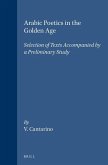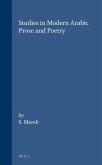This volume deals with "wa?f" or description which is one of the salient characteristics of the "qa dah" (classical Arabic poetry) tradition. The Introduction offers the theoretical background of "wa?f" and ekphrasis ("verbal representation of non-verbal texts" in its modern sense) that can be considered a Western counterpart of "wa?f," The main part of the book examines descriptive passages in a selected group of Arabic "qa dah" from different ages (J?hil?, Abbasid, Andalusian) with the motifs of horses, bees and honey-gathering, visual artifacts, performance of song, and architecture. Approaching the Arabic ode in light of modern Western critical theory, including the theories of ekphrasis and of interarts studies, this work is original and innovative, so it leads to a new understanding of a major form of traditional Arabic poetry.
Hinweis: Dieser Artikel kann nur an eine deutsche Lieferadresse ausgeliefert werden.
Hinweis: Dieser Artikel kann nur an eine deutsche Lieferadresse ausgeliefert werden.








